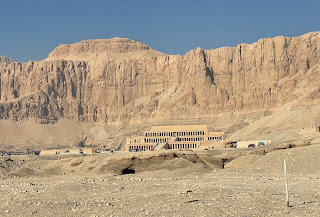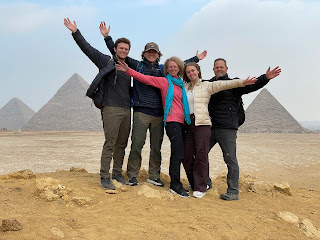West Bank of Luxor - Day 10
Luxor (Ancient Thebes) is considered by many to be the world's greatest open-air museum for the fact that in an area of 161 square miles are some of the most majestic temples such as the Valley of the Kings, Queen Hatshepsut's Temple, Karnak Temple, and Luxor Temple - holding extraordinary ruins and artifacts.
Deir el-Bahri temple complex in Luxor's West Bank
Luxor is split into two banks by the Nile River. The East Bank of Luxor was for the living - their first life. The West Bank was the Valley of the Dead.
Normally the first stop of a day on the West Bank, the Valley of Kings' ticket line has been taking our guide 1 1/2 hours so today we are saving it for last.
When Luxor was the capital of Egypt, its Kings learned from their predecessors. In 16th BC, 1000 years after the Great Pyramid was built, they stopped building such visible beacons beckoning thieves to come steal their vast treasures. Here in Luxor they hid their tombs on the West Bank.
Our first stop was Deir El Medina. No site in all of Egypt has contributed more to our understanding of everyday village life for the common Egyptian than Deir el-Medina. Also known as as "The Valley of the Workers", Deir el-Medina is home to the remains of an ancient Egyptian settlement created to house the small army of laborers and artisans it took to man the ongoing construction of tombs in the nearby Valley of the Kings.
Everything done here in the valley of workers was secret; the valley was hidden and could not even be seen from a distance.
The Valley of the Workers is proof that the work was not done by slaves who were then killed to keep the location secret. A privilege to work and live here, the artisans were highly skilled and passed the knowledge to their children.
In their free time, the workers used their specialized skills to build their own tombs. The tomb was considered the house for eternity so they spent their efforts making it nicer than their living home.
Definitely not the flagship of the Luxor sites, the village was our favorite stop. Climbing and squeezing down into the narrow tombs was fun, the hieroglyphics were impeccably intact, and we practically had the place to ourselves.
The workers even included the pyramid, their stairway to heaven.
The tomb entrances are plain and nondescript.
Watch your head! As short as Kate and I are, even we have to duck.
Wow! You crawl through the tightly enclosed tunnel to discover brightly colored hieroglyphics that leave you in awe.
The drawings and hieroglyphs in the workers' tombs are still very much intact and retain quite a bit of their original colors. Our guide said that this 3000 year-old tomb is the most impressive tomb in Egypt.
The security guard in each tomb tries to play tour guide and take family pictures. The German in front of us allowed the guard to speak to her. She tipped him in euros and he stopped her saying it wasn't enough. Our guide said she has seen them stop people and not let them leave.
The worker's village also has their own temple, which is equally as impressive as their tombs.
The hypostyle hall and columns with papyrus capitals in the Temple of the Deir El-Medina.
The Temple of the Deir El-Medina is the only place you find the Final Judgement carved.
The colorful carvings of the judges lined up to determine if the King will enter the afterlife.
The family of gods we keep seeing repeated in all the hieroglyphics in Egypt: Osir Nuit Isis Horus Neftis Anubs (from right to left)
Next we went to see the memorial temple of the Pharaoh who broke all the rules in Egypt. Hatshepsut ("Hat-ship-suit") was the longest reigning and most successful female Pharaoh in Egypt's history. During her reign as regency for her stepson and nephew (Thutmose III), not only did she declare herself king in a time it was forbidden for women to rule, she also claimed she had divine blood - the blood of the gods.
Hatshepsut's greatest achievement was the enormous memorial temple at Deir el-Bahri, considered one of the architectural wonders of ancient Egypt.
You can buy tickets to take the electric car the short distance to the temple and tombs. Feels just like the tram at Disneyland!
After Hatshepsut's death, her successor, Thutmose III, destroyed her statues and chiseled out her images to obliterate her memory. (You can see one of her only remaining intact statues at The Met in NYC.)
Chiseled out names, symbols, and images on the left side. On the right side, Thutmose III name is still intact and preserved.
The Valley of the Kings is the most famous archeological site in the whole world. There are 63 impressive tombs and your ticket includes your choice of 3. The popular or impressive tombs, like Tutankhamun's, have a separate entrance fee.
There is nothing remarkable to see above ground here at the Valley of the Kings.
At the ticket entrance of The Valley of the Kings was this pretty cool model of what the tombs look like both above and below the surface - mapping the tombs' deep chambers. (Deeper tombs meant the King ruled for many years.)
We went into Ramses IV, Ramses IX, and Ramses III and paid the extra entrance fee to see the tomb of Ramses V and VI.
When you enter the tombs, you walk deep down the shaft to the burial chamber.
The walls of the tombs are covered with hieroglyphics.
The tomb of Ramses V and VI (KV 9) requires an additional ticket because it is so impressive. With some of the broadest corridors, longest shafts (383ft) and greatest variety of decoration, KV 9 is one of the most spectacular tombs in the valley. Started by Ramses V and finished by Ramses VI, much of its surface is covered with intact hieroglyphs and paintings containing scenes from all of the Divine books.
The pillared hall in the tomb of Ramses V and VI.
The digging of Ramses V and VI burial chamber was not fully completed.
Our last activity of the day was a horse carriage ride through the streets of Luxor. I was afraid an hour and a half was going to be overkill but the ride was so fascinating that it flew by.
The horse carriage ride gave us a completely different perspective than we could get from a car, yet was a protective bubble from the hagglers. It immersed us in the local neighborhoods giving us a taste of what their daily life is like. 3:30pm - 5:00pm was a good time of day to witness a lot of a local hustle and bustle. Being on the carriage allowed us to feel a connection to the activity.
We are staying across from Luxor Temple
Logistics:
In the 15 feet in front of our hotel that Greg walked to an ATM, he was stopped three times for a taxi. Our guide assured us that Luxor is quite safe but the taxi and carriage drivers are an annoyance.
One big thing I do not like about Egypt is the tipping ("baksheesh"). I don't carry any money and don't like paying extra for every single service from directions to using the restroom (5EGP/$0.20). I haven't figured out how much is the correct amount to tip. The internet says 10%, or 15% if you are pleased with the service. However, JJ told me a MUCH higher rate up to 75% and that is what I have been following. My justification is that most people here are extremely underpaid, and contributing to less-developed countries is part of the harmony of travel.
The sites in Luxor require an expiration date on student IDs in order to get the student rate. Our three cards from California universities do not have an expiration but they were willing to accept them anyway.
If you can have a local arrange a horse carriage for you, it is much easier. Our guide warned that often the drivers will agree to one rate, only to change it during your ride. The short ride from Karnak to Luxor is 150 EGP. Our 1 1/2-hour ride around Luxor was 250 EGP per carriage.





























Comments
Post a Comment